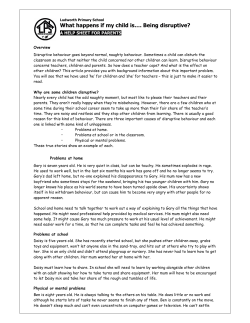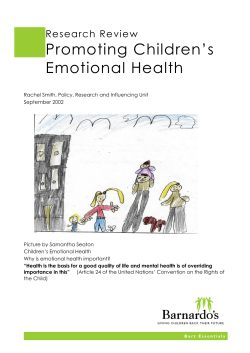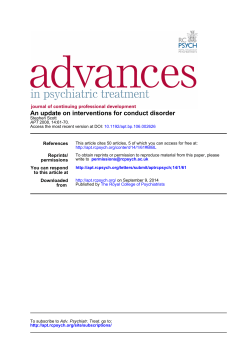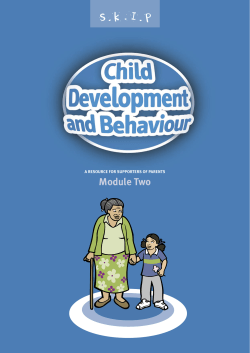
COGNITIVE BEHAVIOUR THERAPY CAN BE EFFECTIVE IN MANAGING BEHAVIOURAL PROBLEMS AND
COGNITIVE BEHAVIOUR THERAPY CAN BE EFFECTIVE IN MANAGING BEHAVIOURAL PROBLEMS AND CONDUCT DISORDER IN PREADOLESCENCE WHAT WORKS FOR CHILDREN? This Evidence Nugget should be cited as: Joughin, C. Cognitive behaviour therapy can be effective in managing behavioural problems and conduct disorder in pre-adolescence. What Works for Children group: Evidence Nugget; September 2003. This nugget is available from www.whatworksforchildren.org.uk In the UK, 7.4% of boys and 3.2% of girls from 5 to 15 years of age exhibit conduct disorder. Cognitively based problem solving skills training has been widely evaluated and there is evidence for its efficacy in the short term, in treating aggression and conduct disorders in children. • 40% of 7 to 8 year olds diagnosed with conduct disorder become persistent offenders as teenagers; over 90% of persistent offenders had conduct disorder as children. • Cognitive behavioural therapies (CBT) emphasise the process of learning in maintaining behaviour. The client is encouraged to identify connections between thoughts and their negative effects. • Mild conduct problems may be ameliorated with the help of combined training in both social and anger management coping skills. • The use of problem solving skills training in the management of conduct disorders has been shown to have the most powerful impact where combined with parent training and family-based interventions. The searches for this Evidence Nugget were done in 2002, with some updates in 2003, in response to reviewers’ comments. The value of this document is time-limited as new research becomes available. For further details on the individual studies readers are recommended to go back to the original articles included. -1- What is Cognitive Behaviour Therapy? CBT places an emphasis on certain cognitive techniques that are designed to produce changes in thinking and therefore changes in behaviour or mood.4 Cognitive behavioural theories also emphasise the learning process and the ways in which a child’s external environment can change both cognition and behaviour. CBT for children and adolescents usually includes a range of behaviour performance-based procedures, and often involve the family or school in therapy. It may include individual work, group sessions or both. The length of treatment varies considerably and depends on the severity of difficulties experienced. Individual programmes for children and adolescents with conduct disorder are often quite long and may take up to 25 or 30 weekly sessions. The therapist is active and involved and tries to develop a collaborative relationship that stimulates the child to think for him or herself. The approach aims to give the child the opportunity to try things out and develop new skills.4 For children with conduct disorder and aggression CBT usually has a strong focus on social cognitions and interpersonal problem solving. Two types of CBT Social Skills and Anger Coping Skills Training A range of CBT approaches have been developed which focus on the distorted understanding of social events that children with CD experience. The programmes focus on modifying and expanding the child’s interpersonal appraisal processes so that they develop a more sophisticated understanding of beliefs and desires in others, as well as improving the child’s capacity to regulate his or her own emotional response2. Problem Solving Skills Training A basic ingredient in CBT with children is problem-solving. Problemsolving skills training attempts to remedy the deficits in cognitive problemsolving processing abilities that are often found in aggressive children and adolescents. Training children in problem-solving helps them to deal with external problems, which may provoke behaviours. The child is first encouraged to identify a solvable problem and then to generate as many potential solutions as possible. The best solution is chosen, the steps to carry it out are identified, and the child tries it out. The whole process is then evaluated.4 -2- What are behavioural problems and conduct disorders? Most children will occasionally exhibit difficult behaviour such as temper tantrums or occasional aggressive outbursts, but this behaviour becomes problematic when persistent. Children with frequent disruptive behaviour are usually classified as experiencing “emotional and behavioural difficulties” (EBD) and may be registered as having “special educational needs” in the United Kingdom. Young children with similar behaviours may also be described as having “oppositional defiant disorder” (ODD). Conduct disorder (CD) is a more extreme form of disruptive behaviour. The pattern is so severe it interferes with the child’s ability to learn and develop. It is characterised by persistent aggressive or antisocial behaviour, deliberate damage to property, cruelty to other people or animals, theft, deceit, serious rule violation and bullying.6 Isolated dissocial or criminal acts are not in themselves grounds for diagnosing CD, but would require an enduring pattern of behaviour of at least six months for such a diagnosis to be made.7 Juvenile delinquency is a sociological, rather than a diagnostic category, that refers to children and adolescents who break the law. Delinquent behaviour may well lead to, or be part of, a conduct disorder, but not all children or adolescents who offend are conduct disordered. Children with CD who are aggressive have been found to differ from their peers in that they respond to fewer social cues, and direct their attention selectively towards hostile social cues, making it more likely that they will interpret stimuli in a hostile way.8 When confronted with social problems, conduct disordered children generate fewer solutions than children who do not have CD. Cognitive behaviour therapy (CBT) aims to target the attitudes and beliefs underlying such behaviours. A frequent problem is that research does not adequately describe the severity and complexity of the difficulties these children experience, and a wide range of terms are used to describe behavioural and conduct problems. For the purpose of this Nugget the terms conduct disorder and behavioural problem is used interchangeably to encompass the range of behaviours described above. Impact Size of the problem Conduct disorders frequently co-exist with a range of problems such as Attention Deficit Hyperactivity Disorder (ADHD), depression and anxiety. In the United Kingdom, rates of sub-clinical conduct disorder are difficult to verify, partly because of overlapping classification systems (e.g. ODD, EBD) and partly because EBD has no strict diagnostic criteria.9 Rates of conduct disorder in the UK are reported to be 7.4% of boys and 3.2% of girls aged 515 years.6 -3- Short and long term effects Costs for the child are high. Disruptive behaviours are associated with poor academic achievement, low self-esteem, low frustration tolerance, poor social skills and depressive symptoms.4 They are more likely to truant from school and more likely to be in trouble with the police. As adults they are more likely to have increased rates of substance abuse, mental health disorders, relationship breakdown, and unemployment. These adults are also more likely to commit crime and abuse their children.10 Children who show behaviour indicative of EBD, ODD and CD may suffer damage to relationships with family, peers and teachers. The disruptive behaviour can interfere with both classroom teaching and the behaviour of other children. The economic cost of such behaviour is high. In addition to educational needs, costs can include community health referrals, GP visits, involvement of social services, law enforcement agencies, and probation services, as well as the cost of property damage. Of 7 to 8 year olds with conduct disorder, 40% become persistent offenders as teenagers, and over 90% of persistent offenders had a conduct disorder as children.10,11 Who will benefit the most? Children with conduct disorders are more likely to be living in lone parent families, with parents who have no educational qualifications, in families where neither parents are employed, in low-income households or in social sector housing.12 Obviously, this does not mean that children from these backgrounds are all conduct disordered, even if the proportion is larger than in other groups. Research evidence Randomised control trial (RCT): An RCT is an experiment in which individuals are randomly allocated to receive or not receive a service (or to receive a different service) and then followed up to determine the effect of the service in relation to specific outcomes. Systematic Reviews: A systematic review is a method of comprehensively identifying, critically appraising, summarising and attempting to reconcile the research evidence on a specific question.2,3 A meta-analysis is a statistical technique combining results from several studies into one overall estimate of the effect of an intervention. There is a vast body of literature examining the effectiveness of psychological interventions on children with behavioural problems. This section presents a range of evidence both secondary research (systematic reviews and metaanalyses) and primary research (RCTs). For the purpose of this Nugget we -4- have not attempted to search for individual primary research studies but have used a recent review of treatments for children and adolescents, prepared by Fonagy and colleagues for the Department of Health.1 Child-based CBT interventions seem to have a positive effect in decreasing antisocial behaviour. A recent meta-analysis indicated that CBT may have a larger effect with older school-aged children and adolescents than with younger children, although this finding should be read with caution due to study design.13 Some studies of CBT show improved behaviours up to one year after treatment whereas others have found that gains do not persist. More research is needed in this area. Social skills and anger coping skills training: There is evidence from an RCT and a controlled programme evaluation that mild conduct problems may be ameliorated with the help of social skills and anger management coping skills training, but there is no evidence for the use of these approaches on their own or with more chronic and severe cases.1 Problem-solving skills training: Problem solving skills training is the most investigated singular approach to the cognitive-behavioural treatment of conduct problems. Its effectiveness in combination with parent training has been demonstrated by 2 studies and this would seem to be the treatment of choice for severe conduct problems in children aged 8-12 years.1 There is frequently a problem with large drop out rates (between 40% - 60%) from such combination approaches. A Barriers to Treatment Measure has been designed5 and this offers the potential for devising specific interventions aimed at the therapeutic engagement of families at high risk of drop out.1 A recent review of randomised and non-randomised programmes targeting aggression14 suggests that some variations in effectiveness emanate from the programme strategy, while a significant portion is explained by other programme characteristics such as implementation, format, and intensity.. The authors stress the importance of having well implemented, relatively intense, one-to-one programmes conducted by trained staff. There is some evidence that CBT interventions for adolescents administered in groups may make conduct problems worse.1 Research suggests that children with worst eventual outcomes become more aggressive over time, and early intervention is recommended to prevent this negative effect.15-17 Limitations of the evidence Whilst research has shown that some aspects of CBT may be effective, there are limitations to the current evidence. Although CBT is acknowledged to have a clear structure that has been well evaluated, critics argue that other widely used alternative interventions (e.g. consultation work, paediatric liaison) have been overlooked. The lack of systematic evaluation of these -5- alternatives makes it difficult to assess their effectiveness, which may result in bias towards evaluated approaches. In addition, CBT evaluations have been criticised for using mostly “demonstration programmes” (programmes introduced for the purpose of research and not part of routine practice). Evidence suggests that routine practice programmes may have a smaller effect than demonstration programmes, although the latter can show what is achievable under optimal circumstances. While problem-solving skills training in combination with parent training programmes seems to be the treatment of choice for conduct disorders in children aged 8 to 12 years, it is likely that no single treatment approach will be sufficient. Behavioural problems in children may be affected by both family and child factors, and problems may occur during interactions with parents, teachers or peers. Some children with conduct disorders do not respond to CBT; children with a comorbid diagnosis, with poor peer relationships, or who come from dysfunctional families seem to be less likely to respond. It should also be noted that the clinical significance of the changes found in some studies is unclear; many children continue to have some conduct problems after treatment.18 What are the policy and practice implications? In the UK it is common policy that children with emotional or behavioural difficulties should be retained within mainstream schools with behaviour management plans in place wherever possible. This makes schools potential contact and treatment points for children. Consider your target population when deciding which is the most appropriate intervention. Children with conduct disorder often have lower than average (verbal) intelligence with a short attention span, and it may be appropriate to tailor the CBT to include less discussion and be more action-orientated.8 The preferred treatment should take into account the diagnosis and age of the child. In many cases, particularly for those children showing co-morbidity, multiple treatments may be needed, requiring multidisciplinary teams, possibly including health, social services, education, juvenile justice, and voluntary sector agencies to deliver integrated programmes of care.1 Practitioners with knowledge of cognitive behavioural therapy theory and practice will certainly need to be included in the development of a programme, and possibly in the delivery. The United Kingdom Council for Psychotherapy offers information on seeking an accredited psychotherapist or on training the relevant staff, specific for your chosen intervention. Contact details for this and other organisations can be found in the ‘Contents’ section at the end of this nugget. There are at present only limited formal training opportunities for CBT. The application of cognitive-behavioural methods requires a knowledge of social -6- learning principles and a variety of different skills. These skills can be readily taught but this does take time. There is evidence that proper training in the psychological therapies enhances clinical efficacy.18 What are the resource implications? The costs of cognitive behavioural therapy will vary greatly depending on the programme chosen, and whether it is integrated into existing services or targeted at a particular high-risk group. Initial assessment is important and may be costly when using a CBT approach because implementation will be tailored to the needs of each young person.19 A recent (2000) estimate of the cost of employing a Clinical Psychologist, based on a mid-point salary and including on-costs and overheads, is £28 per hour overall and £64 per client contact hour.20 Other professionals or nonprofessionals may be able to deliver this intervention, but appropriate training will be an important and significant budgeting consideration. Cost-analysis of CBT in other contexts have shown it to be a cost effective intervention21 and in particular in relation to youth offending.22,23 A costanalysis of BT and CBT for disruptive behaviour in children has not yet been conducted. How will you audit an intervention using CBT? Audit provides a method for systematically reflecting on and reviewing practice. It aims to establish how close practice is to the agreed level of best practice. This is achieved by setting standards and targets and comparing practice against these. Consider whether cognitive behavioural therapy for behavioural problems is appropriate for the needs of your community and your agency. Might other interventions be more effective or appropriate? Would it be more appropriate to offer CBT in conjunction with other approaches? Then consider whether the conditions in your agency are in place for this approach to be implemented. Do you have the funds, people and training resources that you would need to implement behavioural training programmes? When introducing a targeted intervention such as this, it is worth considering how your scheme will be accessed, whether self-referral routes will be included? How will you ensure the young people at greatest risk are offered, attracted to, and complete such a scheme? Further down the line, what proportions of young people referred or requesting behavioural training are offered therapy? Of these, what proportions attend / complete the therapy? -7- How will you evaluate an intervention using CBT? Service evaluation may be defined as a set of procedures to judge a service’s merit by providing a systematic assessment of its aims, objectives, outcomes and costs. Audit may be one activity which takes place during a service evaluation, alongside other activities such as routine data gathering, incident reporting and interviews with staff and service users. You will need to identify and collect baseline data for relevant outcomes (e.g. school or home behaviour, school attendance and disciplinary records, contact with police). Specify clearly what the participant characteristics are. Behaviour can be assessed using standardised assessments (e.g. Strength and Difficulties Questionnaire24). For young children, it may be more feasible to look at behaviours reported by teachers or parents rather than self-reported anger. You may wish to include other problems associated with conduct disorder and EBD (e.g. Attention Deficit/Hyperactivity Disorder). Comparing baseline data to post-intervention data will enable you to determine any changes in behaviour. Try to be specific in what you choose to look at. The best evidence of effects will be gained if you can compare a group of young people who received the intervention (the intervention group) to a group of young people who did not receive any treatment (the control group). It may be difficult to prevent those involved in the study (e.g. teachers) from knowing which group an individual was allocated to, and this may introduce bias. Programmes may vary in selection of target groups, the delivery (and quality) of services, types of treatment conducted, and the intervention goals.15 Children in many schools have a range of disruptive behaviours not associated with anger control25, and often these complex cases are omitted from studies.1 As well as looking at the overall effects on behaviour, remember to monitor the experiences of the participants, including for potential negative consequences (e.g. risk of stigmatisation) for children, parents, teachers, and service providers. Drop out rates should also be included and recorded. Implementing evaluation in a methodological manner not only allows you to make conclusions about what works best, but also adds to the current evidence base for other practitioners. -8- Contacts The United Kingdom Council for Psychotherapy has a website detailing training information for psychotherapy, and finding a suitably qualified psychotherapist at www.ukcp.org.uk The British Association of Behavioural and Cognitive Psychotherapies (BABCP) is a multi-disciplinary interest group for people involved in the practice and theory of behavioural and cognitive psychotherapy. BABCP disseminates information and maintains standards for practitioners. Further information is available at www.babcp.org.uk. The Royal College of Psychiatrists produces a leaflet for parents on conduct disorder, what the consequences may be, and how it can be managed at home. (Royal College of Psychiatrists, 17 Belgrave Square, London SW1X 8PG Tel: 020 7235 2351 Fax: 020 7245 1231 Website: www.rcpsych.ac.uk The Royal College of Psychiatrists produces an online resource for CBT at www.rcpsych.ac.uk/info/webguide/cogthe.htm The Association of Workers for Children with Emotional and Behavioural Disorders (AWCEBD) offers information for professionals within the field, and can be contacted through: Allan Rimmer, Administrative Officer, Charlton Court, East Sutton, Maidstone. ME17 3DQ Tel: 01622 843104 Fax: 01622 844220 Email: awcebd@mistral.co.uk Website: www.awcebd.co.uk The National Association for the Care and Resettlement of Offenders (NACRO) work with ex-offenders using CBT and other programmes to reduce re-offending. They also have outreach projects across the country working to engage disaffected young people before they become involved in crime. They publish papers and leaflets on their strategies for engaging youth and may have a service locally that you could visit or model. They can be contacted at: NACRO, 169 Clapham Rd, London SW9 0PU Tel: 020 7582 6500 Fax: 020 7735 4666 Website: www.nacro.org.uk Search Strategy: A search strategy documents how studies were found; which databases/libraries/other contacts were used to find studies and when, what key words were used to locate them and what limitations were put on the search. Age limits: 5 years up to adolescent Search terms: (cognitive behavio* therapy), (systematic reviews), meta-analysis Databases searched: Cochrane database of systematic reviews, Database of Abstracts and Reviews of Effectiveness (DARE), PsycINFO, ERIC, British Educational Index (BEI) In addition experts in the field were contacted for guidance on other sources of information, and bibliographies of sources viewed were examined for additional references. The conclusions made should be viewed in the light of this restricted search strategy, and we would recommend a systematic review in this area is overdue. -9- The Research Team This Evidence Nugget was produced by the ESRC funded initiative ‘What Works for Children?’ The search and review of the literature was carried out by: • Carol Joughin • Kristin Liabo • Patricia Lucas • Diane Rowland Members of the What Works for Children Research Group The Child Health Research and Policy Unit, City University, London: • Helen Roberts • Carol Joughin • Greg Khine • Kristin Liabo • Patricia Lucas • Alison Moore • Madeleine Stevens Barnardo’s Policy, Research and Influencing Unit: • Tony Newman • Di McNeish • Sarah Frost Department of Health Sciences, University of York: • Trevor Sheldon Acknowledgements What Works for Children? would like to acknowledge the helpful assistance of the following colleagues who commented on an earlier draft of this Evidence Nugget or provided information. The views expressed in this publication are those of the authors and not necessarily those of the colleagues who read and commented or the Economic and Social Research Council (ESRC). • • Brandon Welsh, University of Massachusetts, Lowell Mick Fleming, The University of York Reference List 1. Fonagy, P., Target, M., Cottrell, D., Phillips, J., and Kurtz, Z. What works for whom? A critical review of treatments for children and adolescents. Guildford Press:2002. 2. Petticrew, M. Systematic reviews from astronomy to zoology: myths and misconceptions. British Medical Journal 2001;322:98-101. 3. NHS Centre for Reviews and Dissemination, York University. The Database of Abstracts of Reviews of Effects (DARE). Effectiveness Matters 2002;6:(2)1-2. 4. Sanders, M. R., Gooley, S., and Nicholson, J. Early interventions in conduct problems in children. The Australian Early Intervention Network for Mental Health in Young People.:2000. - 10 - 5. Armbruster, P. and Kazdin, A. E. Attrition in child psychotherapy. In: Ollendick, T. H and Prinz, R. J. (Eds). Advances in Clinical Child Psychology. New York: Plenum; 6. Scott, A., Shaw, M., and Joughin, C. Finding the evidence. A gateway to the literature in child and adolescent mental health. London: Gaskell; 2001. 7. World Health Organisation. The ICD-10 classification of mental and behavioural disorders: Clinical descriptions and diagnostic guidelines. Geneva.: World Health Organisation.; 1992. 8. Van de Wiel, N., Matthys, W., Cohen-Kettenis, P. C, and Van Engeland, H. Effective treatments of school-aged conduct disordered children: recommendations for changing clinical and research practices. European Child & Adolescent Psychiatry 2002;11:79-84. 9. Rutter, M., Tizard, J., and Whitmore, K. Education, Health and Behaviour. London: Longman; 2002. 10. Scott, S. Fortnightly review: aggressive behaviour in childhood. British Medical Journal 17-1-1998;316:(7126)202-206. 11. Scott, S., Knapp, M., Henderson, J., and Maughan, B. Financial cost of social exclusion: follow up study of antisocial children into adulthood. British Medical Journal 2001;323:191-194. 12. Meltzer, H., Gatward, R., Goodman, R., and Ford, T. Mental health of children and adolescents in Great Britain. Office for National Statistics:2000. 13. Bennett, D. S. and Gibbons, T. A. Efficacy of Child CognitiveBehavioral Interventions for Antisocial Behavior: A Meta-Analysis. Child & Family Behavior Therapy 2001;v22 n1 p1-15 2000.: 14. Wilson, S. J., Lipsey, M. W., and Derzon, J. H. The effects of schoolbased intervention programs on aggressive and disruptive behaviour: A meta-analysis. 15. Durlak, J. A., Wells, A. M., Reddy, L. A., and Pfeiffer, S. I. Evaluation of indicated preventive intervention (secondary prevention) mental health programs for children and adolescents. American Journal of Community Psychology 1998;26:(5)775-802. 16. Wilson, S. J., Lipsey, M. W., and Derzon, J. H. The effects of schoolbased intervention programs on aggressive and disruptive behaviour: A meta-analysis. 17. Stage, Scott A and Quiroz, David R. A meta-analysis of interventions to decrease disruptive classroom behavior in public education settings. School Psychology Review 1997;26:(3)333-368. - 11 - 18. Harrington, R. Cognitive-behavioural therapies for children and adolescents. In: Gelder, M. G., Lopez-Ibor J.J., and Andreasen, N. C. (Eds). New Oxford Textbook of Psychiatry. New York: Oxford University Press; 2000. 19. Ronen, T. Linking developmental and emotional elements into child and family cognitive-behaviour therapy. In: Graham, P. (Eds). Cognitive-behaviour therapy for children and families. Cambridge: Cambridge University Press; 20. Department for Education and Skills. 2003 Available from: http://www.dfes.gov.uk/publications/guidanceonthelaw/1099/exclude.htm 21. Netten, A., Rees, T., and Harrison, G. Unit costs of health and social care 2001. University of Kent, Canterbury, Personal Social Services Research Unit:2001. http://www.ukc.ac.uk/PSSRU [cited 2003 Apr 23] 22. Farrington, D., Petrosino, A, and Welsh, B. C. Systematic reviews and cost-benefit analyses of correctional interventions. The Prison Journal 2001;81:(3)339-359. 23. Robertson, A. A., Grimes, P. W., and Rogers, K. E. A short-run costbenefit analysis of community-based interventions for juvenile offenders. Crime & Delinquency 2001;47 (2):265-284. 24. Goodman, R. The Strength and Difficulties Questionnaire: A research note. Journal of Child Psychology and Psychiatry 1997;38:(581)58625. Wilson, S. J., Lipsey, M. W., and Derzon, J. H. The effects of schoolbased intervention programs on aggressive and disruptive behaviour: A meta-analysis: in press. Journal of Consulting and Clinical Psychology 2002;71:(1)136-149. - 12 -
© Copyright 2025





















